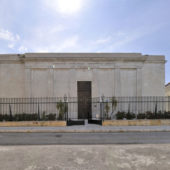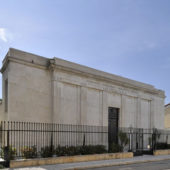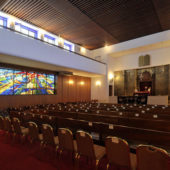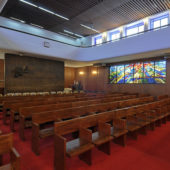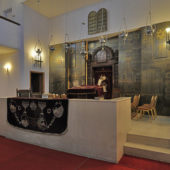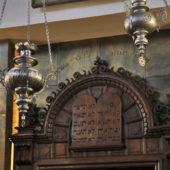The main synagogue of Athens, home to most of the Jews of Greece.
Athens presently has largest Jewish population in Greece. Long ago, after the absorption by Byzantium of the Classical Greek Empire and the Roman Eastern Empire, Athens was not a favorable place for Jews to live because of its prolific pagan lifestyle. From the time the ancient synagogue of Agora was destroyed in the 5th century until the 19th century, the Jewish community of Athens did not have a synagogue. At the beginning of WWII, approximately 3,000 Jews lived in Athens. This number swelled as Jews in the north of Greece fled to Athens during the war. Thanks to the strong resistance movement, the Greek Orthodox Church, and the efforts of the Chief Rabbi of Athens, many Jews hidden throughout Athens were spared from the Holocaust. Currently, there are approximately 3,000 Jews living in Athens and there are two synagogues, Beth Shalom and the older Ioanniotiki.
Beth Shalom (Hebrew for House of Peace) is the synagogue most widely used by Jews in Athens today. It was built in the 1930s by the Sephardic community, on the original site where Jewish refugees from Asia Minor held religious sermons. However, the interior was not completed prior to WWII. Today, the services held in this Orthodox Synagogue are conducted in Hebrew.
Beth Shalom’s exterior is designed in an austere Greek Revivalist style, of white Pentelic marble. Inside, the prayer-room shows evidence of neo-classical styling, with large modern stained glass windows adorning the wood paneled side-walls. Unusual in Greek synagogues, the tivah (reader’s desk) and echal (Aron Kodesh) are joined together by a raised platform. Against a white wall at the front of the sanctuary, a large wall-covering gray and gold artwork with geometric symbols and Stars-of-David serves as a background for the intricately carved wood Aron Kodesh. Tablets with The Ten Commandments inscribed in Hebrew are carved into the top of the Aron Kodesh and a maroon velvet Torah curtain with gold embroidery and tassels is drawn across it. Several silver-colored incense burners hang down in front of the Aron Kodesh. The tivah sits in front of the Aron Kodesh, draped with a maroon velvet cover with gold embroidery. A low white wall runs across the front of the bimah, also draped with a maroon velvet cloth with gold embroidery. As is customary in Greek synagogues, the women’s gallery is upstairs, along the sides and back of the sanctuary. Wood pews fill the sanctuary.
During WWII, Jews were either in hiding or exterminated by the Nazis; therefore, during that time, the Synagogue was not in use. As the interior had not been completed prior to the war, it was finished in 1975 and Beth Shalom been an active Synagogue since that time. Indeed, Beth Shalom is the primary Synagogue in Athens today.

